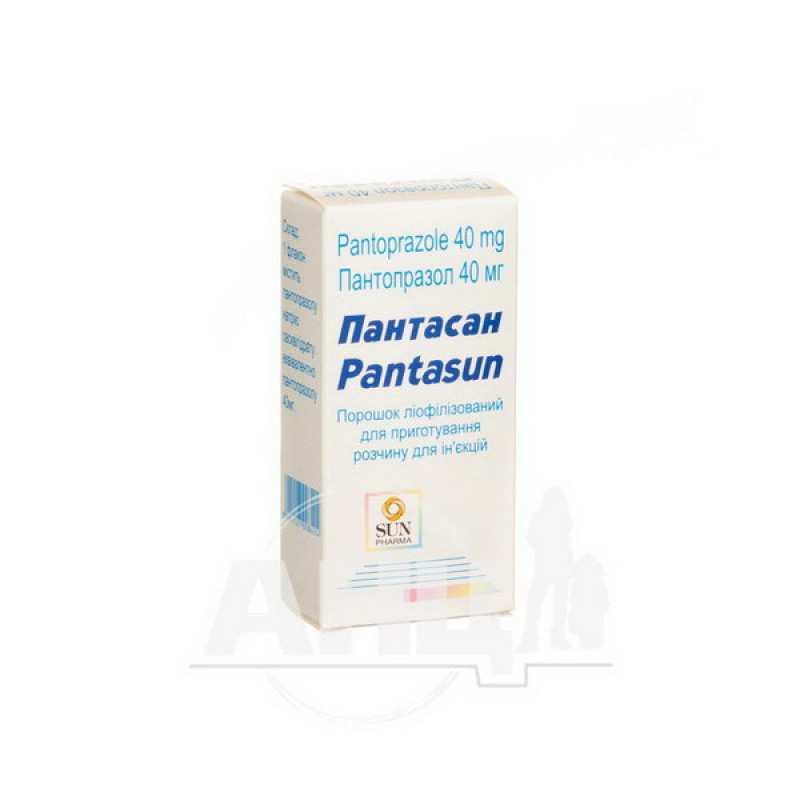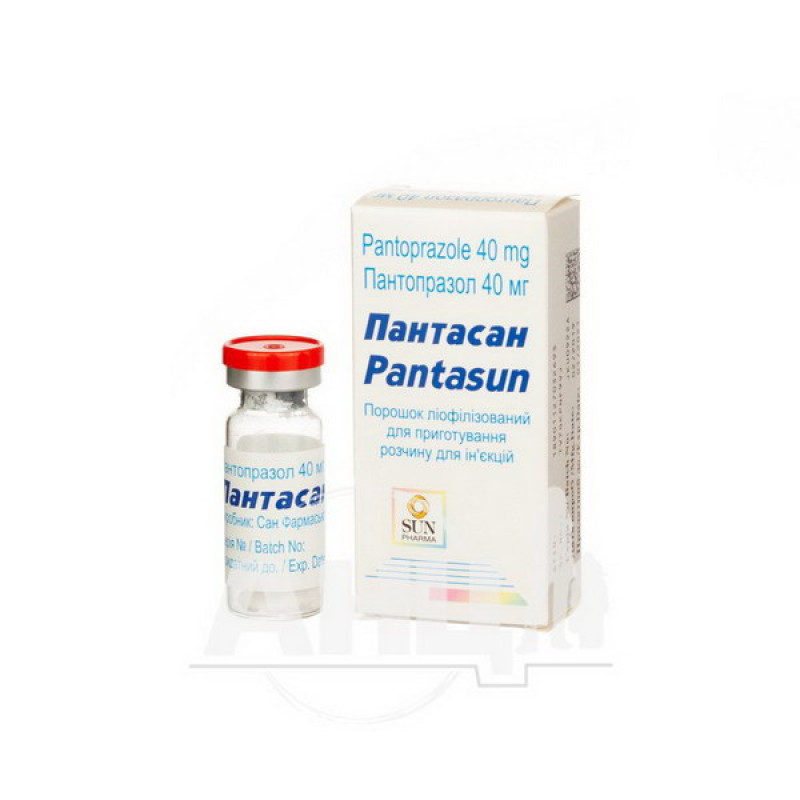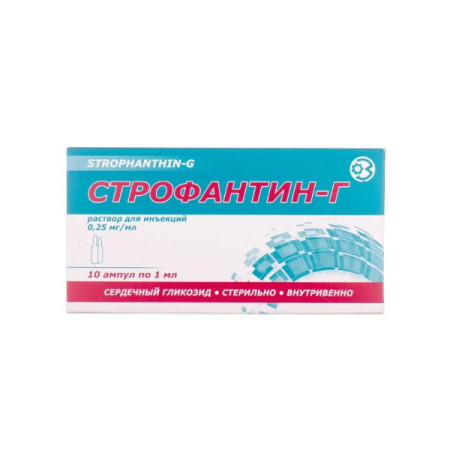Pantasan lyophilized powder for preparation of solution for injection 40 mg bottle with solvent in ampoules 10 ml No. 1

Pharmacological properties
Pharmacodynamics. Pantoprazole is a substituted benzimidazole that inhibits gastric acid secretion by specific blockade of the proton pump of parietal cells. Pantoprazole is converted to its active form in the acidic environment of the parietal cells, where it inhibits the enzyme N + / K + -ATPase, i.e. blocks the final stage of gastric acid production. Inhibition is dose-dependent and inhibits both basal and stimulated acid secretion. In most patients, symptoms disappear within 2 weeks. The use of pantoprazole, as with other proton pump inhibitors and H2-receptor inhibitors, reduces gastric acidity and thus increases gastrin secretion in proportion to the decrease in acidity. The increase in gastrin secretion is reversible. Since pantoprazole binds the enzyme distal to the cellular receptor, it can inhibit the secretion of hydrochloric acid regardless of stimulation by other substances (acetylcholine, histamine, gastrin). The effect is the same with oral and intravenous administration.
When using pantoprazole, the fasting gastrin level increases. With short-term use, it does not exceed the upper limit of normal in most cases. With long-term treatment, the gastrin level increases by 2 times in most cases. Its excessive increase occurs only in rare cases. As a result, in a small number of cases, with long-term treatment, a slight or moderate increase in the number of enterochromaffin-like (ECL) cells in the stomach (similar to adenomatous hyperplasia) is noted.
The effect of long-term (more than 1 year) treatment with pantoprazole on the endocrine function of the thyroid gland cannot be excluded.
Pharmacokinetics. Absorption. Pantoprazole is absorbed, and C max in blood plasma is reached after a single oral dose of 40 mg. On average, 2.5 hours after administration, C max in blood plasma is reached at a level of about 2-3 μg/ml. The concentration remains at a constant level after multiple administration. Pharmacokinetic properties do not change after a single or repeated administration. In the dose range of 10-80 mg, the pharmacokinetics of pantoprazole in blood plasma remains linear both when taken orally and when administered intravenously. It has been established that the bioavailability of tablets is about 77%. Simultaneous food intake does not affect AUC or C max in blood plasma, and, accordingly, bioavailability. When taken simultaneously with food, only the variability of the latent period increases.
Distribution: The binding of pantoprazole to plasma proteins is 98%. The volume of distribution is about 0.15 l/kg.
Elimination. The substance is metabolized almost exclusively in the liver. The main metabolic pathway is demethylation by CYP2C19 followed by sulfate conjugation; another metabolic pathway is oxidation by CYP3A4. The terminal T½ is about 1 h and the clearance is 0.1 l/h/kg. Due to the specific binding of pantoprazole to the proton pump of parietal cells, the T½ does not correlate with the much longer duration of action (inhibition of acid secretion).
The main part of the metabolites of pantoprazole is excreted in the urine (about 80%), the rest - in the feces. The main metabolite in both blood plasma and urine is desmethylpantoprazole, conjugated with sulfate. T ½ of the main metabolite (about 1.5 h) is not much higher than T ½ of pantoprazole.
Indication
Reflux esophagitis; for the eradication of Helicobacter pylori (H. pylori) in patients with gastric and duodenal ulcers caused by this microorganism, in combination with certain antibiotics; duodenal ulcer; gastric ulcer; Zollinger-Ellison syndrome and other pathological hypersecretory conditions.Application
Treatment of reflux esophagitis. The recommended dose for children over 12 years of age and adults is 1 tablet of Pantasan 40 mg once a day. In some cases, the dose can be doubled (2 tablets of Pantasan 40 mg/day), especially if other drugs for the treatment of reflux esophagitis have not had an effect. The treatment of reflux esophagitis usually takes 4 weeks. If this is not enough, a positive clinical effect can be expected within the next 4 weeks.
Eradication of H. pylori in combination with two antibiotics. In patients with gastric and duodenal ulcers and positive for H. pylori, eradication of the organism should be achieved using combination therapy. Depending on the susceptibility of the organism, the following therapeutic combinations may be prescribed for the eradication of H. pylori in adults:
a) 1 tablet of Pantasan 2 times a day
+ 1000 mg of amoxicillin 2 times a day
+ 500 mg of clarithromycin 2 times a day;
b) 1 tablet of Pantasan 40 mg 2 times a day
+ 400-500 mg metronidazole (or 500 mg tinidazole) 2 times a day
+ 500 mg of clarithromycin 2 times a day;
c) 1 tablet of Pantasan 40 mg 2 times a day
+ 1000 mg of amoxicillin 2 times a day
+ 500 mg metronidazole (or 500 mg tinidazole) 2 times a day.
When using combination therapy for eradication of H. pylori, the second tablet of the drug should be taken in the evening 1 hour before meals. The treatment period is 7 days and can be extended for another 7 days with a total duration of treatment of no more than 2 weeks.
Treatment of stomach ulcers. 1 tablet of Pantasan per day. In some cases, the dose can be doubled (2 tablets per day), especially if there is no effect from the use of other drugs.
It usually takes 4 weeks to heal a stomach ulcer. If this is not enough, healing can be expected within another 4 weeks.
Treatment of duodenal ulcer. 1 tablet of Pantasan per day. In some cases, the dose can be doubled (2 tablets per day), especially if there is no effect from the use of other drugs.
Duodenal ulcers usually take 2 weeks to heal. If this is not enough, healing can be expected within another 2 weeks.
Treatment of Zollinger-Ellison syndrome and other hypersecretory pathological conditions. For long-term treatment of Zollinger-Ellison syndrome and other pathological hypersecretory conditions, the initial daily dose is 80 mg (2 tablets of Pantasan 40 mg each). If necessary, the dose can then be titrated up or down depending on the indicators of acid secretion in the stomach. If the dose exceeds 80 mg/day, it should be divided into 2 doses. A temporary increase in the dose above 160 mg of pantoprazole is possible, but the duration of use should be limited only to the period necessary for adequate control of acid secretion.
The duration of treatment for Zollinger-Ellison syndrome and other pathological conditions is not limited and depends on clinical necessity.
In patients with severe hepatic impairment, the dose may be reduced to 20 mg/day. In this case, tablets with an appropriate dosage should be used.
In patients with moderate to severe hepatic impairment, the drug should not be used for the eradication of N. pylori in combination therapy, as there is currently no data on the efficacy and safety of such use in this category of patients.
No dose adjustment is required for patients with impaired renal function. Patients with impaired renal function should not use the drug for eradication of H. pylori in combination therapy, as there is currently no data on the efficacy and safety of such use in this category of patients.
Elderly patients do not require dose adjustment.
Contraindication
Hypersensitivity to pantoprazole or any component of the drug. The drug is not used for combination therapy aimed at eradicating H. pylori in patients with moderate or severe renal or hepatic insufficiency.
Pantoprazole, like other proton pump inhibitors, is not used with atazanavir (see Interactions with other drugs).
Side effects
Blood and lymphatic system disorders: leukopenia, thrombocytopenia, eosinophilia.
On the part of the digestive system: abdominal pain and discomfort, feeling of bloating and distension in the abdomen, diarrhea, constipation, nausea, vomiting, dry mouth, increased appetite.
On the part of the hepatobiliary system: increased levels of liver enzymes (transaminases, γ-glutamyltransferase), bilirubin, hepatocellular disorders, jaundice, hepatocellular insufficiency.
General disorders: edema, asthenia, weakness, fatigue, increased body temperature.
Immune system disorders: Hypersensitivity reactions, including anaphylactic reactions and anaphylactic shock.
Musculoskeletal system: arthralgia, myalgia.
Skin and subcutaneous tissue disorders: itching, skin rashes, exanthema, urticaria, angioedema, erythema multiforme, Lyell's syndrome, Stevens-Johnson syndrome, photosensitivity, alopecia, acne, dermatitis.
From the nervous system: headache, dizziness, tinnitus, tremor, paresthesia, nervousness.
Mental disorders: sleep disorders, insomnia, drowsiness, depression (and increased severity of all symptoms), disorientation (and increased severity of all symptoms), hallucinations.
On the part of the organ of vision: visual impairment, blurred vision, photophobia.
From the urinary system: interstitial nephritis.
Laboratory indicators: hyperlipoproteinemia and increased lipid levels (cholesterol and triglycerides), hyperglycemia, hyponatremia, change in body weight.
From the reproductive system: gynecomastia.
Special instructions
In case of severe liver dysfunction during treatment, especially with prolonged use, regular monitoring of liver enzyme levels is necessary. In case of increased enzyme levels, treatment should be discontinued.
The drug is indicated for the treatment of moderate disorders of the digestive tract (functional dyspepsia).
In the presence of alarming symptoms (significant weight loss, vomiting, dysphagia, haematemesis, anemia, melena) of gastric ulcer, malignancy should be excluded, as treatment with pantoprazole may mask the symptoms of malignant ulcer and delay diagnosis. Further investigations should be performed if symptoms persist despite adequate treatment.
When carrying out combination therapy, which includes pantoprazole, the safety information of each drug should be taken into account.
The use of proton pump inhibitors, including pantoprazole, may lead to an increase in the number of bacteria that normally live in the upper digestive tract. The use of Pantasan may lead to a small risk of gastrointestinal infections caused by bacteria such as Salmonella and Campylobacter.
In patients with Zollinger-Ellison syndrome and other diseases with hypersecretory gastric function, in which it is necessary to use pantoprazole for a long time, as with all antacids, pantoprazole may reduce the absorption of vitamin B12 (cyanocobalamin), which can lead to hypo- or achlorhydria. This should be taken into account with long-term use of the drug and when treating patients with low body weight or the presence of risk factors for reduced absorption of vitamin B12 or corresponding clinical symptoms.
With long-term treatment, especially more than a year, patients should be under constant supervision.
Use during pregnancy and breastfeeding. The drug should be used during pregnancy only if the expected benefit to the mother outweighs the potential risk to the fetus/child.
Pantoprazole passes into breast milk. Breastfeeding should be discontinued when using pantoprazole, taking into account the benefit/risk ratio for the mother and child.
Children. Not prescribed for children under 12 years of age.
Ability to influence the reaction speed when driving vehicles or other mechanisms. In case of dizziness or visual disturbances, driving vehicles or working with other mechanisms should be avoided.
Interactions
The drug may reduce the absorption of drugs whose bioavailability depends on the pH of the gastric contents (for example, ketoconazole, itraconazole, posaconazole and other drugs such as erlotinib).
Co-administration of atazanavir 300 mg/ritonavir 100 mg with omeprazole (40 mg once daily) or atazanavir 400 mg with lansoprazole (60 mg once daily) in healthy volunteers has been shown to significantly reduce the bioavailability of atazanavir. Absorption of atazanavir is pH dependent. Therefore, proton pump inhibitors, including pantoprazole, are contraindicated with atazanavir.
Patients taking anticoagulants, phenprocoumon, warfarin, are recommended to have laboratory tests for platelet coagulation function at the beginning, end and in case of irregular treatment with pantoprazole.
Pantoprazole is metabolized in the liver by P450 enzymes. Interactions of pantoprazole with other drugs metabolized by the same enzyme system are not excluded. However, in special studies with most of these drugs, no clinically significant interactions with carbamazepine, caffeine, diazepam, diclofenac, ethanol, glibenclamide, metoprolol, naproxen, nifedipine, phenytoin, theophylline, piroxicam and oral contraceptives containing levonorgestrel and ethinyl estradiol were found.
No interactions with concomitantly administered antacids were identified.
In a study of the interaction of pantoprazole with relevant antibiotics (clarithromycin, metronidazole, amoxicillin), no clinically significant interaction was found.
Overdose
Symptoms of overdose in humans are unknown. Adverse reactions may be exacerbated.
Doses up to 240 mg when administered intravenously over 2 minutes were well tolerated.
In case of overdose with signs of intoxication, general detoxification measures are used.
Storage conditions
At a temperature not exceeding 25 °C.
There are no reviews for this product.
There are no reviews for this product, be the first to leave your review.
No questions about this product, be the first and ask your question.










